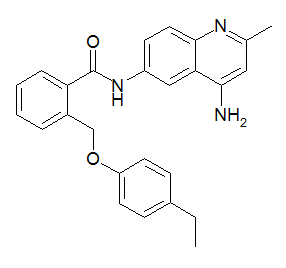
The activin A receptor also known as ACVR1C or ALK-7 is a protein that in humans is encoded by the ACVR1C gene. ACVR1C is a type I receptor for the TGFB family of signaling molecules.

5-Methoxytryptamine (5-MT), also known as mexamine, is a tryptamine derivative closely related to the neurotransmitters serotonin and melatonin. 5-MT has been shown to occur naturally in the body in low levels. It is biosynthesized via the deacetylation of melatonin in the pineal gland.

Zinc finger E-box-binding homeobox 2 is a protein that in humans is encoded by the ZEB2 gene. The ZEB2 protein is a transcription factor that plays a role in the transforming growth factor β (TGFβ) signaling pathways that are essential during early fetal development.

Rilmazafone is a water-soluble benzodiazepine prodrug developed in Japan. It has sedative and hypnotic effects. Rilmazafone induces impairment of motor function and has hypnotic properties.

Interleukin 6 receptor (IL6R) also known as CD126 is a type I cytokine receptor.

Thymidine phosphorylase is an enzyme that is encoded by the TYMP gene and catalyzes the reaction:

Sialidase-3 is an enzyme that in humans is encoded by the NEU3 gene.

Activating transcription factor 5, also known as ATF5, is a protein that, in humans, is encoded by the ATF5 gene.

SNF-related serine/threonine-protein kinase is an enzyme that in humans is encoded by the SNRK gene.

Interleukin-2 receptor subunit beta is a protein that in humans is encoded by the IL2RB gene. Also known as CD122; IL15RB; P70-75.

DNA polymerase eta, is a protein that in humans is encoded by the POLH gene.

Neuregulin 2, also known as NRG2, is a protein which in humans is encoded by the NRG2 gene.

Anisatin is an extremely toxic, insecticidally active component of the Shikimi plant. The lethal dose is 1 mg/kg (i.p.) in mice. Symptoms begin to appear about 1–6 hours after ingestion, beginning with gastrointestinal ailments, such as diarrhea, vomiting, and stomach pain, followed by nervous system excitation, seizures, loss of consciousness, and respiratory paralysis, which is the ultimate cause of death.

JTC-801 is an opioid analgesic drug used in scientific research.

Denopamine (INN) is a cardiotonic drug which acts as a β1 adrenergic receptor agonist. It is used in the treatment of angina and may also have potential uses in the treatment of congestive heart failure and for clearing pulmonary oedema. It is marketed in Japan under the brand name Kalgut (カルグート) and available as tablets of 5 and 10 mg, and 5% fine granules.

Blonanserin, sold under the brand name Lonasen, is a relatively new atypical antipsychotic commercialized by Dainippon Sumitomo Pharma in Japan and Korea for the treatment of schizophrenia. Relative to many other antipsychotics, blonanserin has an improved tolerability profile, lacking side effects such as extrapyramidal symptoms, excessive sedation, or hypotension. As with many second-generation (atypical) antipsychotics it is significantly more efficacious in the treatment of the negative symptoms of schizophrenia compared to first-generation (typical) antipsychotics such as haloperidol.

Matrine is an alkaloid found in plants from the genus Sophora. It has a variety of pharmacological effects, including anti-cancer effects, as well as κ-opioid and μ-opioid receptor agonism.
DNA polymerase IV is a prokaryotic polymerase that is involved in mutagenesis. It exhibits no 3′→5′ exonuclease (proofreading) activity and hence is error prone. In E. coli, DNA polymerase IV is involved in non-targeted mutagenesis. Pol IV is a Family Y polymerase expressed by the dinB gene that is switched on via SOS induction caused by stalled polymerases at the replication fork. During SOS induction, Pol IV production is increased tenfold and one of the functions during this time is to interfere with Pol III holoenzyme processivity. This creates a checkpoint, stops replication, and allows time to repair DNA lesions via the appropriate repair pathway. Another function of Pol IV is to perform translesion synthesis at the stalled replication fork like, for example, bypassing N2-deoxyguanine adducts at a faster rate than transversing undamaged DNA. Cells lacking dinB gene have a higher rate of mutagenesis caused by DNA damaging agents.

Israpafant (Y-24180) is a drug which acts as a selective antagonist for the platelet-activating factor receptor, and was originally developed for the treatment of asthma. Its chemical structure is a thienotriazolodiazepine, closely related to the sedative benzodiazepine derivative etizolam. However israpafant binds far more tightly to the platelet-activating factor receptor, with an IC50 of 0.84nM for inhibiting PAF-induced human platelet aggregation (compared to etizolam's IC50 of 998nM at this target), while it binds only weakly to benzodiazepine receptors, with a Ki of 3680nM. Israpafant has been found to inhibit the activation of eosinophil cells, and consequently delays the development of immune responses. It has also been shown to have anti-nephrotoxic properties, and to mobilize calcium transport.

Fluoromedroxyprogesterone acetate is a synthetic steroid medication which was under development by Meiji Dairies Corporation in the 1990s and 2000s for the potential treatment of cancers but was never marketed. It is described as an antiangiogenic agent, with about two orders of magnitude greater potency for inhibition of angiogenesis than its parent compound medroxyprogesterone acetate. FMPA showed about the same affinities for the progesterone and glucocorticoid receptors as MPA. It reached the preclinical phase of research prior to the discontinuation of its development.



















